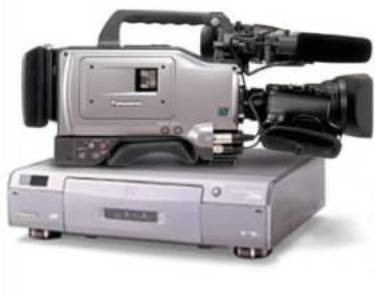Building a Digital Video Capture System - Part I
Capture Card Basics, Continued
DV Camera and Deck - Image courtesy of Panasonic
Analog/DV combination systems will accept input from either a standard analog input or from a DV camera. These systems will give you the most flexibility if you already have an analog camcorder but are considering a DV camcorder sometime in the future.
Virtually all capture cards come with some sort of bundled software that will let you capture and at least do some basic editing. If a $500 price tag for the capture system makes you cringe then take comfort in the fact that you're probably also going to get about $800 worth of bundled software. However, if you have a particular target platform in mind, such as RealVideo or QuickTime for Web streaming then you might have to purchase additional software.
You may also find that once you outgrow the bundled "lite" version of Adobe, Ulead, or Avid software you might want to invest in the full version but be prepared for some serious sticker shock - professional-quality NLE (non-linear editing) software and effects packages can get very expensive.
Beyond these basic features, capture systems differentiate themselves based on speed, built-in transition effects, and bundled software. Just about any system will let you capture video that is suitable for the Web (although that's not saying much). And just about all systems in the $250 on up category will let you capture and manipulate video that is comparable to VHS or better. You're not going to get HDTV-quality unless you spend a small fortune but for under $1,000 you should be able to put together a system that is capable of getting very close to DVD-quality.
With everything, there are compromises and trade-offs. When shopping for a capture system it's always better to opt for the best you can afford. You can always make the image smaller or use a lower frame rate if you need to, but it's difficult to take a small, poor-quality video and try to make it better.
Coming Up
There have been dozens of books and articles and entire magazines and Web sites devoted to video capture and there's no way I can cover everything in one article. In the next installment I'll take a look at some of the systems out there that you can get for under a $1,000, what they can (and can't) do, and how they stack up. In the meanwhile, drag that camcorder out of the closet and go shoot some footage. You'll need something to capture once you've built your own system.
Get Tom's Hardware's best news and in-depth reviews, straight to your inbox.
Guy Wright has worked as a video engineer, video editor, and producer/director for cable and experimental television stations. He is a published science fiction author and author of books on computers and video. He has been Technical Editor, Technical Manager, and Editor-in-Chief for a number of high-tech magazines since 1983 including Run Magazine, Amiga World Magazine, OS/2 Magazine, InterActivity Magazine, and Multimedia Week. He has founded or co-founded four software companies. He has published over 500 articles in more than two dozen high-tech and video magazines. He has lectured at numerous trade shows and conferences. He has also produced over a dozen commercial CD-ROM titles. He is currently a Senior Producer at Digital Media Online where he produces four Web sites - DVDCreation.com, DTVProfessional.com, DigitalGameDeveloper.com, and AVVideo.com.
